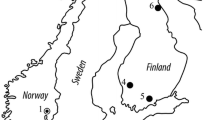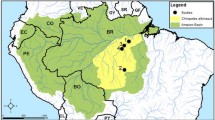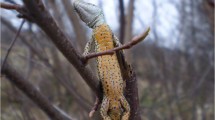I calculated rates of predation by 2 species of diurnal raptors, Polyboroides radiatus and Accipiter henstii, on the lemur community of Ranomafana National Park, Madagascar from 2700 h of observation and 470 prey deliveries at 7 nests of each hawk species. The 2 hawks consumed 7 of 12 lemurs found in the park region, with a body mass of 63–3500 g and including diurnal and nocturnal species of all group sizes. Calculations of predation rates indicate that raptor predation is a significant cause of mortality for lemur populations relative to other causes. Minimum rates of predation by Polyboroides radiatus and Accipiter henstii on Microcebus rufus, Cheirogaleus major, Avahi laniger, Hapalemur griseus, Eulemur fulvus rufus, Eulemur rubriventer, and Varecia variegata resulted in the raptors removing of 1–21% of the population per yr, similar to other rates of predation on primates documented in the literature. Modeling of lemur populations under varying levels of raptor predation pressure that I calculated found that one may attribute 3–17% of adult, juvenile, and infant mortality for nocturnal lemurs and 2–66% of adult, juvenile, and infant mortality for diurnal lemurs to diurnal raptor predation. Raptor predation may significantly depress intrinsic growth rates and carrying capacity of Avahi laniger, Hapalemur griseus, Eulemur fulvus rufus, Eulemur rubriventer, and Varecia variegata owing to their low fecundities, long life spans, and long age to sexual maturation. Nocturnal lemurs may best avoid predation by diurnal raptors by exhibiting a solitary lifestyle and cryptic antipredator tactics, whereas, diurnal lemurs benefit less by increasing group size than by using specific antipredator tactics.






Similar content being viewed by others
REFERENCES
Akcakaya, H. R., Burgman, M. A., and Ginzburg, L. R. (2002). Applied Population Ecology, Applied Biomathematics, Setauket, New York.
Akcakaya, H. R., and Root, W. (2002). RAMAS Ecolab, Applied Biomathematics, Setauket, New York.
Arrigo-Nelson, S. J., and Wright, P. C. (2004). Survey results from Ranomafana National Park: New evidence for the effects of habitat preference and disturbance on the distribution of Hapalemur. Folia Primatol. 75: 331–334.
Atsalis, S. (1998). Seasonal Patterns in Diet, Distribution, and Reproduction of Microcebus rufus in the Rain Forest of Madagascar. Ph.D. Dissertation. CUNY, New York.
Balko, E. (1998). The Behavioral Plasticity of Varecia variegate in Ranomafana National Park, Madagascar. Ph.D. Dissertation. Syracuse University, Syracuse, NY.
Brockman, D. K. (2002). Polyboroides predation attempts on Propithecus verreauxi. Folia Primatol. 74: 71–74.
Cheney, D. L., and Wrangham, R. W. (1987). Predation. In Smuts, B. B., Cheney, D. L., Seyfarth, R. M., Wrangham, R. W., and Struthsaker, T. T. (eds.), Primate Societies, University of Chicago Press, Chicago.
Clutton-Brock, T. H., and Harvey, P. H. (1977). Primate ecology and social organization.J. Zool. Lond. 183: 1–39.
Collar, N. J., Cosby, M. J., and Stattersfield, A. J. (1994). Birds to Watch 2: The World List of Threatened Birds. Birdlife Conservation Series: 4, Birdlife International, Cambridge.
Crooks, K. R. (2002). Relative sensitivities of mammalian carnivores to habitat fragmentation. Conserv. Biol. 16: 488–502.
Curtis, D. J., Zaramody, A., and Martin, R. D. (1999). Cathemerality in the Mongoose Lemur, Eulemur mongoz. Am. J. Primatol. 47: 279–298.
Fichtel, C., and Kappeler, P. M. (2002). Anti-predator behavior of group-living Malagasy primates: Mixed evidence for a referential alarm call system. Behav. Ecol. Sociobiol. 51: 262–275.
Glander, K. E., Wright, P. C., Merenlender, A., and Daniels, P. S. (1992). Morphometrics and testicle size of rain forest lemur species from southeastern Madagascar. J. Hum. Evol. 22: 1–17.
Glatston, A. R. H. (1979). Reproduction and Behaviour of the Lesser Mouse Lemur. Ph.D. Dissertation. University of London, London.
Goodman, S. M. (1994a). Description of a new species of subfossil eagle from Madagascar: Stephanoaetus (Aves: Falconiformes) from the deposits of Ampasambazimba. Proc. Biol. Soc. Wash. 107: 421–428.
Goodman, S. M. (1994b). The enigma of anti-predator behavior in lemurs: Evidence of a large extinct eagle on Madagascar. Int. J. Primatol. 15: 129–134.
Goodman, S. M., O’Conner, S., and Langrand, O. (1993). A review of predation on lemurs: Implications for the evolution of social behavior in small, nocturnal primates. In Kappeler, P. M., and Ganzhorn, J. U. (eds.), Lemur Social Systems and Their Ecological Basis, Plenum Press, New York, pp. 51–66.
Goodman, S. M., and Rakotozafy, L. M. A. (1995). Evidence for the existence of two species of Aquila on Madagascar during the quaternary. GEOBIOS 28: 241–246.
Grassi, C. (2001). The Behavioral Ecology of Hapalemur griseus griseus: The Influences of Microhabitat and Population Density on This Small-Bodied Prosimian Folivore. Ph.D. Dissertation. University of Texas, Austin, TX.
Janson, C. H. (1998). Testing the predation hypothesis for vertebrate sociality: Prospects and pitfalls. Behaviour 135: 389–410.
Janson, C. H. (2003). Puzzles, predation, and primates: Using life history to understand selection pressures. In Periera, M., and Kappeler, P. (eds.), The Role of Life Histories in Primate Socioecology, Chicago University Press, Chicago.
Jenkins, D., Watson, A., and Miller, G. R. (1964). Predation and Red Grouse populations. J. Appl. Ecol. 1: 183–195.
Johnson, S. E., Irwin, M. T., Wright, P. C., Arrigo-Nelson, S., Grassi, C., Samonds, K. C., and Smith, T. M. (2003). Natural and anthropogenic influences of lemur population structure in southeastern Madagascar. Am. J. Phys. Anthrop. Suppl 36: 123.
Kappeler, P. M. (1997). Determinants of primate social organization: Comparative evidence and new insights from Malagasy lemurs. Biol. Rev. 72: 111–151.
Karpanty, S. M. (2003). Behavioral and Ecological Interactions of Raptors and Lemurs in Southeastern Madagascar: A Multiple-Predator Approach. Ph.D. Dissertation. SUNY Stony Brook, Stony Brook, NY.
Karpanty, S. M., and Goodman, S. M. (1999). Diet of the Madagascar Harrier-Hawk, Polyboroides radiatus, in southeastern Madagascar. J. Raptor Res. 33: 313–316.
Karpanty, S. M., and Grella, R. (2001). Lemur responses to diurnal raptor calls in Ranomafana National Park, Madagascar. Folia Primatol. 72: 100–103.
Langrand, O. (1990). Guide to the Birds of Madagascar, Yale University Press, New Haven.
Merenlender, A. (1993). The Comparative Population Biology of Two Lemur Species. Ph.D. Dissertation. University of Rochester, Rochester, NY.
Merenlender, A., Kremen, C., Rakotondratsima, M., and Weiss, A. (1998). Monitoring impacts of natural resource extraction on lemurs of the Masoala Peninsula, Madagascar. Conserv. Ecol. 2(2), Article 5, http://www.consecol.org/Journal/vol2/iss2/art5/.
Mikkelson, G. M. (1993). How do food webs fall apart: A study of changes in trophic structure during relaxation on habitat fragments. Oikos 67: 539–547.
Mitani, J. C., Sanders, W. J., Lwanga, J. S., and Windfelder, T. L. (2001). Predatory behavior of crowned hawk eagles (Stephanoaetus coronatus) in Kibale National Park, Uganda. Behav. Ecol. Sociobiol. 49: 187–195.
Mittermeier, R. A., Tattersall, I., Konstant, W. R., Meyers, D. M., and Mast, R. B. (1994). Lemurs of Madagascar, Conservation International, Washington, DC.
Newton, I. (1993). Predation and limitation of bird numbers. Curr. Ornithol. 11: 143–198.
Newton, I. (1998). Population Limitation in Birds, Academic Press, London.
Overdorff, D. J. (1991). Ecological Correlates to Social Structure in Two Prosimian Primates: Eulemur fulvus rufus and Eulemur rubriventer in Madagascar. Ph.D. dissertation. Duke University, Durham, NC.
Overdorff, D. J. (1995). Life history and predation in Eulemur rubriventer in Madagascar. Am. J. Phys. Anthrop. 96: 164–165.
Overdorff, D. J., Strait, S. G., and Seltzer, R. G. (2002). Species differences in feeding in Milne Edward's sifakas (Propithecus diadema edwardsi), rufus lemurs (Eulemur fulvus rufus), and red-bellied lemurs (Eulemur rubriventer) in southern Madagascar: Implications for predator avoidance. In Miller, L. E. (ed.), Eat or Be Eaten: Predator Sensitive Foraging Among Primates, Cambridge University Press, Cambridge, UK.
Pochron, S. T., Tucker, W. T., and Wright, P. C. (2004). Demography, life history, and social structure in Propithecus diadema edwardsi from 1986 to 2000 in Ranomafana National Park, Madagascar. Am. J. Phys. Anthrop. 125: 61–72.
Rasoloarison, R. M., Rasolonandrasana, B. P. N., Ganzhorn, J. U., and Goodman, S. M. (1995). Predation on vertebrates in the Kirindy Forest, western Madagascar. Ecotropica 1: 59–65.
Ratsimbazafy, J. (2002). On the brink of extinction and the process of recovery: Responses of Black-and-White Ruffed Lemurs (Varecia variegata variegata) to disturbance in Manombo Forest, Madagascar. Ph.D. Dissertation, Stony Brook University, Stony Brook, NY.
Redpath, S. M. (1991). The impact of hen harriers on red grouse breeding success. J. Appl. Ecol. 28: 659–671.
Reed, K. E. (1999). Population density of primates in communities: Differences in community structure. In Fleagle, J. G., Janson, C. H., and Reed, K. (eds.), Primate Communities, Cambridge University Press, Cambridge, UK.
Rene de Roland, L.-A. (2000). Breeding biology of the Henst's Goshawk Accipiter henstii on Masoala Peninsula, northeastern Madagascar. In Chancellor, R. D., and Meyburg, B. U. (eds.), Raptors at Risk, WWGBP, Hancock House, London.
Roth, O. (1997). The Behavior of Avahi laniger and Lepilemur microdon in Ranomafana National Park. M. A. Thesis. University of Basel, Switzerland.
Salia, S. B. (1997). Review of Applied Population Ecology and RAMAS Ecolab. Fisheries. 22: 47–48.
Sauther, M. L. (1989). Anti-predator behavior in troops of free-ranging Lemur catta at Beza Mahafaly Special Reserve, Madagascar. Int. J. Primatol. 10: 595–606.
Sauther, M. L. (2002). Group size effects on predation sensitive foraging in wild ring-tailed lemurs (Lemur catta). In Miller, L. E. (ed.), Eat or Be Eaten: Predator Sensitive Foraging Among Primates, Cambridge University Press, Cambridge, UK.
Shultz, S. (2001). Interactions between crowned eagles and monkeys in Tai National Park, Ivory Coast. Folia Primatol. 72: 248–250.
Shultz, S. (2002a). Crowned eagle population density, diet, and behavior in the Tai National Park, Ivory Coast. Ibis. 144: 135–138.
Shultz, S., and Noe, R. (2002b). The consequences of crowned eagle central-place foraging on predation risk in monkeys. Proc. R. Soc. Lond. B 269: 1797–1802.
Skorupa, J. P. (1989). Crowned Eagles Stephanoaetus coronatus in rainforest: Observations on breeding chronology and diet at a nest in Uganda. Ibis 131: 294–298.
Struhsaker, T. T., and Leakey, M. (1990). Prey selectivity by crowned hawk-eagles on monkeys in the Kibale Forest, Uganda. Behav. Ecol. Sociobiol. 26: 435–443.
Tan, C. L. (2000). Behavior and Ecology of Three Sympatric Bamboo Lemur Species (Genus Hapalemur) in Ranomafana National Park, Madagascar. Ph.D. Dissertation. SUNY Stony Brook, Stony Brook, NY.
van Schaik, C. P., and Kappeler, P. M. (1996). The social systems of gregarious lemurs: Lack of convergence with anthropoids due to evolutionary disequilibrium? Ethology 102: 915–941.
Waller, D. (1998). Review of Applied Population Ecology and RAMAS Ecolab. Q. Rev. Biol. 73: 380–381.
Watson, A., and Moss, R. (1979). Population cycles in the Tetraonidae. Ornis Fenn. 56: 87–109.
Wright, P. C. (1998). Impact of predation risk on the behaviour of Propithecus edwardsi in the rain forest of Madagascar. Behaviour. 135: 483–512.
Wright, P. C. (1999). Lemur traits and Madagascar ecology: Coping with an island environment. Yrbk. Phys. Anthropol. 42: 31–72.
Wright, P. C., and Andriamihaja, B. A. (2002). Making a rain forest park work in Madagascar: Long term research commitment in Ranomafana National Park. In Terborgh, J., van Schaik, C., Davenport, L., and Rao, M. (eds.), Making Parks Work, Island Press, California.
Wright, P. C., Heckscher, S. K., and Dunham, A. E. (1997). Predation on Milne-Edward's Sifaka (Propithecus diadema edwardsi) by the Fossa (Cryptoprocta ferox) in the rain forest of southeastern Madagascar. Folia Primatol. 68: 34–43.
Wright, P. C., and Martin, L. B. (1995). Predation, pollination, and torpor in two nocturnal prosimians: Cheirogaleus major and Microcebus rufus in the rain forest of Madagascar. In Alterman, L. E. A. (ed.), Creatures of the Dark: The Nocturnal Prosimians, Plenum Press, New York, pp. 45–60.
ACKNOWLEDGMENTS
The National Science Foundation Pre-doctoral Fellowship, United States Environmental Protection Agency STAR Fellowship (U-91554301), Wildlife Conservation Society Research Fellowship Program, National Science Foundation Dissertation Improvement Grant (Proposal no. 0200747), National Geographic Committee for Research and Exploration (Award no.7295-02), International Osprey Foundation, Margot Marsh Biodiversity Foundation, Slobodkin Research Award, and Stony Brook University Graduate School provided funding for the project. I thank Drs. Charles Janson, Patricia Wright, Lawrence Slobodkin, and Rick Watson for their helpful comments on this manuscript and my entire dissertation. I thank the Association Nationale pour la Gestion des Aires Protégées (ANGAP) and the Direction des Eaux et Forets (DEF) in Madagascar for permission to conduct this research in and around Ranomafana National Park. The project was made possible with the assistance of the Institute for the Conservation of Tropical Environments (ICTE), the Malagasy Institute pour la Conservation des Environnements Tropicaux (MICET), and a team of dedicated guides and students: Loret Rasabo, Ramarojoana Perle Mamisoa, Sabo, Rafanomezantsoa Sedrarimanona Angelo, Rakotomalala Miandrisoa Jeannot, Randrianantenaina Johnny, Samuel, Randrianalenarina Mamy, Razafy Mahatratra Maurice, Fahatelo Gista, Rakotonirina Telo, Randrianarivo Jeannot, Rakotonjatovo Justin, Filybert, Velotsara Jean Baptiste, Djaizandry Bertrin, Sapna Sopori, Cassie Rogge, Anna Scheinzbach, and Kimberly May. I thank two anonymous reviewers for their helpful comments on this manuscript.
Author information
Authors and Affiliations
Corresponding author
Rights and permissions
About this article
Cite this article
Karpanty, S.M. Direct and Indirect Impacts of Raptor Predation on Lemurs in Southeastern Madagascar. Int J Primatol 27, 239–261 (2006). https://doi.org/10.1007/s10764-005-9008-x
Received:
Accepted:
Published:
Issue Date:
DOI: https://doi.org/10.1007/s10764-005-9008-x




